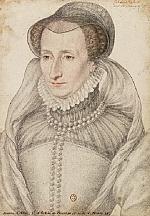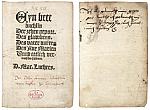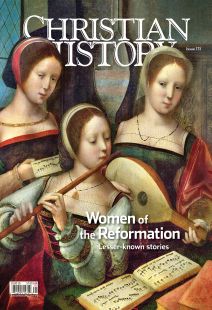No simple story

[Teresa of Ávila and her nuns]
IN JANUARY 1540 Martin Luther’s family experienced a crisis common to many families and yet too rarely acknowledged publicly by the church. His wife, Katharina von Bora (1499–1552), had a miscarriage that left her gravely ill to the point that she was unable to walk until months afterward.
No strangers to the untimely death of a child, the Luthers had lost their one-year-old daughter, Elisabeth, 12 years earlier. The heartbreaking miscarriage was soon followed by the death of their second daughter, Magdalena (1529–1542), who passed away at age 13 after enduring sickness and suffering.
Out of his own experience and with sympathy for parents facing the tragic loss of a child, Luther poured himself into the writing of a foreword to a book by his friend and pastor Johannes Bugenhagen on Psalm 29. Luther’s short essay was called “Consolation for Women Whose Pregnancies Have Not Gone Well” (1542).
God has not limited God’s power
Luther strongly defended mothers against the culture’s tendency to lay the tragedy at their feet. No doubt with his own Katharina in mind, Luther affirmed the anguished prayers of mothers struggling to articulate their grief to God. One question that would have plagued his audience was whether God’s presence had a place for the unbaptized, stillborn child—a pastoral care situation never handled easily by a medieval church that maintained infant baptism washed away original sin. Luther assured grieving mothers that God’s promises were not rooted in the physical administration of baptism but in the covenantal promise to the families of believers:
Who can doubt that those Israelite children who died before they could be circumcised on the eighth day were yet saved by the prayers of their parents, in view of the promise that God willed to be their God? God has not limited God’s power to sacraments but has made a covenant with us through God’s own word.
Would Luther have written this piece if he had not been a husband and a father as well as a pastor and a theologian? It seems unlikely. The work, the struggles, and the spiritual lives of women as wives were now up close and personal for pastors in a prominent and legitimate way once forbidden to clergy. Allowing clergy to marry had significantly changed the game. Indeed this and other rapid developments of the Reformation would serve to uniquely shape and complicate the day-to-day faith of women. Reformation scholar Merry Wiesner-Hanks wrote about this tumultuous time in Sixteenth-Century Journal:
Women were not simply passive recipients of the Reformation message, but left convents, refused to leave convents, preached, prophesied, discussed religion with friends and family, converted their husbands, left their husbands, wrote religious poems, hymns, and polemics, and were martyred on all sides of the religious controversy.
These women were both willing and unwilling participants in the seismic shifts taking place in their communities. They conceded and defied their circumstances even to the point of great risk and sacrifice, and populated every branch of the Reformation as devoted Roman Catholics, Lutherans, Reformed, and Anabaptists. While some took great risk to escape convents, others despaired at their closing when they were left to fend for themselves in a society ill prepared to receive them. Describing their stories leaves us with a richer and more robust picture of the Reformation as it challenged men and women alike to reconsider the status quo and grapple with old and new dimensions to life and faith. One thing is certain: as the fires of reform swept the Continent, they burned up the rule book regarding women’s roles.
When one door closes
The closing of the convents proved the most transformational change to womens’ daily lives. Before the Reformation a substantial portion of Europe’s female population lived in convents. Here their lives revolved around religious practice, and they enjoyed educational opportunities largely unavailable otherwise.
In the best of circumstances, the convent was an attractive opportunity for fostering female piety and spiritual leadership. Those who had experienced this resisted forcible ejection from their lifelong monastic homes in the sixteenth century. Jeanne de Jussie (1503–1561) wrote one troubling account of the events surrounding the closing of the convent of the Poor Clares in Geneva in 1535, detailing the many hardships women experienced in displacement. She took particular offense when one Protestant female reformer, Marie Dentière, suggested that a husband would solve her woes:
In that company was a nun, a false, wrinkled abbess with a devilish tongue, who had a husband and children, named Marie Dentière of Picardy, who meddled in preaching and perverting pious people. . . . She said, “Oh, you poor creatures, if you knew what a good thing it is to be next to a handsome husband and how pleasing to God!”
To leave the convent required entering a society not prepared to receive, resettle, and reestablish female lives. Homeless, impoverished, and unmarried former nuns depended on the social welfare of Protestant city governments in such cases. Navigating the shifting landscape was challenging to all, but women felt its difficulty most acutely—social, cultural, political, and economic restrictions bound their lives, and sixteenth-century society was simply not equipped for untethered, self-supporting women.
But monastic life had not been the vocational hope of all women. In its worst form, for those locked in monastic cells as young as toddlers, the closing of the convents and the prospect of marriage offered a welcome respite. Out of this experience we get the unforgettable story of Katharina von Bora’s daring escape as one of a dozen nuns fleeing the convent of Nimbschen hidden in a fish wagon on the evening of Easter Sunday in 1523.
After biding her time, von Bora eventually married Luther in 1525 and would come to manage their expansive household, exercising talents from industry to finance. Luther came to love her dearly and recognize her exceptional talents by (literally) giving her a seat at the theological table, as we can see from his Table Talk, and seeking to skirt gender laws over inheritance on her behalf through his will in 1542. Katie Luther was an exception in many ways, but she also represents a new norm that treated marriage and motherhood, not the life of a celibate nun, as the primary expression of female piety.
Wives and witches
The medieval church had worked for centuries to advance a culture of celibacy as the highest expression of the Christian life for both men and women. Despite such efforts the systemic problem of clergy defying their vows and keeping concubines (called “Nicolaitism”) became the pivot of the church’s structural corruptions. The fathering of illegitimate children by priests opened the door for extortion and blackmail within the ranks (simony) as well as the purchasing of church offices by priests for their sons (nepotism, from the Latin word for nephew—many priests’ “nephews” were actually sons).
Priests also frequented brothels to quell sexual desires. This web of corruption was interrelational, intergenerational, and ever expanding—reaching all the way to the seat of Peter. Alexander VI, pope from 1492 to 1503, openly legitimized four of his children after he became pope, including the famous Lucrezia Borgia, and he probably fathered six more. In this setting the cry for medieval reform was often tied to a recommitment to celibacy. Unfortunately celibacy campaigns tended to disparage womanhood and marriage to advance their cause. Common tropes of the era about marriage included, “Take a wife, and get a devil on your back” or “Brief is the joy, lasting the bitterness.”
The church all too frequently advanced a denigrated view of women through an appeal to nature, Scripture, and theology. Females were thought to be no better than prepubescent males, less than fully human, created in sin and for sin, and lacking God’s sacred image. These views were all par for the course in the medieval period, though inherited from early church fathers and from Greek philosophers such as Aristotle. By the sixteenth century, these disparaging views surrounding womanhood formed an integral part of celibacy propaganda—and the campaign to rid the church of heresy and witchcraft.
Malleus Maleficarum (The Hammer of Witches), written by two Dominican priests in the late fifteenth century, came on the scene with a fury thanks to the stamp of approval it received from a papal bull. “Woman” is depicted there as feeble in mind and body while prone to sexual deviance and theological heresy.
The Hammer argues that either God created woman defective and fleshly, or else devils conceived her; in any case, woman existed only as a “necessary evil” for the reproduction of future males. The impact of this document was devastating to women, particularly old and poor widows, who experienced the brunt of the witch-craze wrath in regions that used torture liberally for criminal prosecution.
The Reformers responded to the celibacy dispute by stressing the importance of marriage (though not as a sacrament) and, by extension, the theological dignity of womanhood. In contrast to prevalent voices in the celibacy campaigns, many Protestants taught that woman was made a good creation and in the image of God. Therefore mutual respect between spouses was warranted. As Luther wrote even before his marriage to von Bora, “Each should honor the other’s image and body as a divine and good creation that is well-pleasing to God himself.”
Reforming marriage
In the writings of Calvin, the blame once heaped solely upon Eve for her role in ushering original sin into the world was also extended to Adam, an atypical move for the period. When traditional readings of passages like 1 Timothy 2:15 seemed to threaten the idea that women have equal access to salvation through justification by faith alone, Luther reinterpreted the passage saying, “For Christ, our Savior, did not hold woman in contempt but entered the womb of a woman. Paul also reflected on this [when he wrote], ‘Woman will be saved through bearing children,’ etc.”
To the Reformers the battle to redeem marriage was a fight with the devil. Calvin wrote in his commentary on Genesis, “The more Satan has endeavored to dishonor marriage, the more should we vindicate it from all reproach and abuse, that it may receive its due reverence.” Importantly this reverence extended to marriage meant theological reverence for womanhood.
These were not just mere theological affirmations; these teachings had a noticeable impact in Reformation society. Protestant city councils closed brothels as part of their efforts to protect marriage. Church liturgies moved the marriage ceremony to the prominence of the Sunday morning worship context.
Meanwhile institutional bodies such as the Genevan Consistory dedicated countless hours of their disciplinary activity to what amounted to marital counseling. Women were encouraged to participate in the spiritual instruction of their children, which was one of the primary motivations for the Reformation’s movement to educate girls. Zurich reformer Heinrich Bullinger promoted motherhood as the foremost expression of female piety in On Christian Marriage (see p. 11). Even so motherhood was not the only avenue for the Reformation’s pious women.
Pious women, manly courage
Women were also drawn to receive and advance the theological message and mission of the Reformation. Former abbess Dentière, though her efforts were not approved by de Jussie, worked tirelessly from Geneva to promote reform among women—encouraging the closing of convents and writing “to give courage to other women detained in captivity, so as they might not fear being expelled from their homelands, away from their relatives and friends, as I was, for the word of God.” Dentière’s story (see “A very useful epistle,” p. 16) captures how the Reformation message compelled women to embrace reform and to enter the theological fray with their own words.
Luther’s earliest convictions about the priesthood of all believers, his emphasis on the authority of Scripture, his reformulation of justification, and his appeal to Christian freedom all played significant roles in encouraging the participation of women in the Protestant Reformation. Luther’s reading of 1 Peter 2:9 early on was particularly empowering: “Because the words of Peter are written to all Christians . . . it follows that the holy, pious women and children are tonsured and anointed priests. . . .” With this encouragement and more, a flurry of female authors began to publish pamphlets advancing the Reformation message.
Whether you read Argula von Grumbach (see “Our first woman reformer,” pp. 17–20), Katharina Schütz Zell (see “She would follow only Christ,” pp. 29–32), or several generations later Anna Maria van Schurman (1607–1678), reoccurring themes emerge. These women writers celebrated the right to finally receive, read, and learn from the Word of God. They appealed to their baptism as the basis for their shared priesthood. They emphasized how the Holy Spirit could use all people for God’s purpose and cited Balaam’s donkey in Numbers 22 as an illustration. They quoted Jesus’s words—“Whoever confesses me before another I too will confess before my heavenly Father” (Matthew 10:32)—to prove Christ’s intention that both men and women could proclaim the Good News.
Above all they made it clear that they ultimately answered to God instead of men and cited the Parable of the Talents in Matthew 25 in support. Rather than cast aside their gifts, they would use them to God’s glory. Von Grumbach wrote to the faculty at Ingolstadt, “I don’t intend to bury my talent, if the Lord gives me grace.” They preached, they published, and they read. In the case of Anabaptist women, they suffered imprisonment, shared their biblical convictions in court, and received martyrdom. The pious women of the Reformation showed “manly courage” (as one Anabaptist text put it) in numerous regards.
Another door opens
In the end, although the closing of the convents meant a significant change for women’s roles in the church, it did not prove to be the death knell of female church leadership. The rise of the roles of pastor’s wife and pastor’s daughter was no small development. For the first time since before the days of Charlemagne, the pastor’s family became a legitimate and respectable family unit within the life of the church.
Moreover renewed attention to the church’s offices according to the Pauline epistles led to the recovery and reestablishment of the office of deacon, and with this came the retrieval of the female diaconate. Deaconesses primarily cared for the poor; this became a ministry of widows and single women particularly.
The church of Geneva and Reformed churches in the Netherlands actively encouraged and advanced deaconess ministry; the office may have existed as early as 1566 at the Reformed Church in Amsterdam, although the consistory did not record the names of the women until 1582. Selection went by the same procedure as the selection of male deacons, although the female deacons never participated in the consistory gathering or managed the finances. Still it was an official vehicle for female church ministry.
Finally, as the centuries wore on, the Protestant emphasis on the priesthood of all believers was used as a theological basis for permitting women to enter the ordained ministry as clergy. Beginning with seventeenth-century German Pietism, then in nineteenth-century evangelical congregationalism and twentieth-century mainline Protestantism, Protestantism became the only branch of the church to allow and in fact to encourage the female priesthood. When one door closes, another door opens… CH
By Jennifer Powell McNutt
[Christian History originally published this article in Christian History Issue #131 in 2019]
Jennifer Powell McNutt is Franklin S. Dyrness Chair for Biblical and Theological Studies at Wheaton College, the author of Calvin Meets Voltaire, and the coeditor of The People’s Book: The Reformation and the Bible. She is ordained in the Presbyterian Church (USA).Next articles
Like mother, like daughter?
Marguerite de Navarre and Jeanne d’Albret shaped French religion for generations
S. Amanda Eurich“A very useful epistle”: Marie Dentière
In 2002 Dentière received belated recognition; her name was added to the Wall of the Reformers in Geneva.
Mary B. McKinleyOur first woman reformer
Argula von Grumbach proclaimed “no woman’s chit-chat, but the Word of God”
Peter MathesonSupport us
Christian History Institute (CHI) is a non-profit Pennsylvania corporation founded in 1982. Your donations support the continuation of this ministry
Donate







